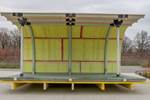Damen, CEAD explore composite 3D printing potential via HDPE Workboat project
Dutch innovators collaborate to investigate large-format 3D printing for functional shipbuilding at the recently opened Maritime Application Center.
HDPE Workboat. Source | CEAD, Damen Shipyards Group
Damen Compact Crafts (DCCr, Gorinchem, Netherlands), part of the , and CEAD B.V. (Delft, Netherlands) are launching a collaboration to develop a 3D printed HDPE Workboat (HWB) using CEAD’s HDPro fiber-reinforced composite material. The project will take place at CEAD’s Maritime Application Center (MAC) in Delft, which was “founded to accelerate exactly these kinds of innovations.” Through this initiative, the two Dutch companies are joining forces to explore the potential of large-format additive manufacturing (LFAM) for the maritime industry.
With this project, Damen aims to investigate how 3D printing technology can contribute to the faster, more sustainable and more flexible production of functional vessels. The HWB is being designed as a versatile vessel, suitable for a wide range of operations, including inspection, support, patrol and logistical tasks. By 3D printing the hull of the boat, not only is more design freedom achieved, but it also opens the possibility of integrating recycled and renewable materials.
For this project, CEAD contributes its expertise in large-format 3D printing and is developing print technologies capable of processing optimal HDPE blends. The project serves as a prime example of how technological innovation and market knowledge can reinforce one another.
“Innovation and standardization are part of our DNA at Damen,” notes Nick Pruissen, managing director at DCCr. “3D printing allows us to respond more quickly and flexibly to what our customers really need.” The success of the 3D printed HWB could open the door to broader applications of additive manufacturing in shipbuilding.
Related Content
-
Combining multifunctional thermoplastic composites, additive manufacturing for next-gen airframe structures
The DOMMINIO project combines AFP with 3D printed gyroid cores, embedded SHM sensors and smart materials for induction-driven disassembly of parts at end of life.
-
The next evolution in AFP
Automated fiber placement develops into more compact, flexible, modular and digitized systems with multi-material and process capabilities.
-
Hitachi Rail chooses Roboze printers, materials including carbon fiber/PEEK for railway spare parts
The Roboze ARGO 500 will be used at Hitachi Rail factories in Naples, Italy and Maryland, U.S. to reduce cost and delivery times for prototypes and spare parts.



